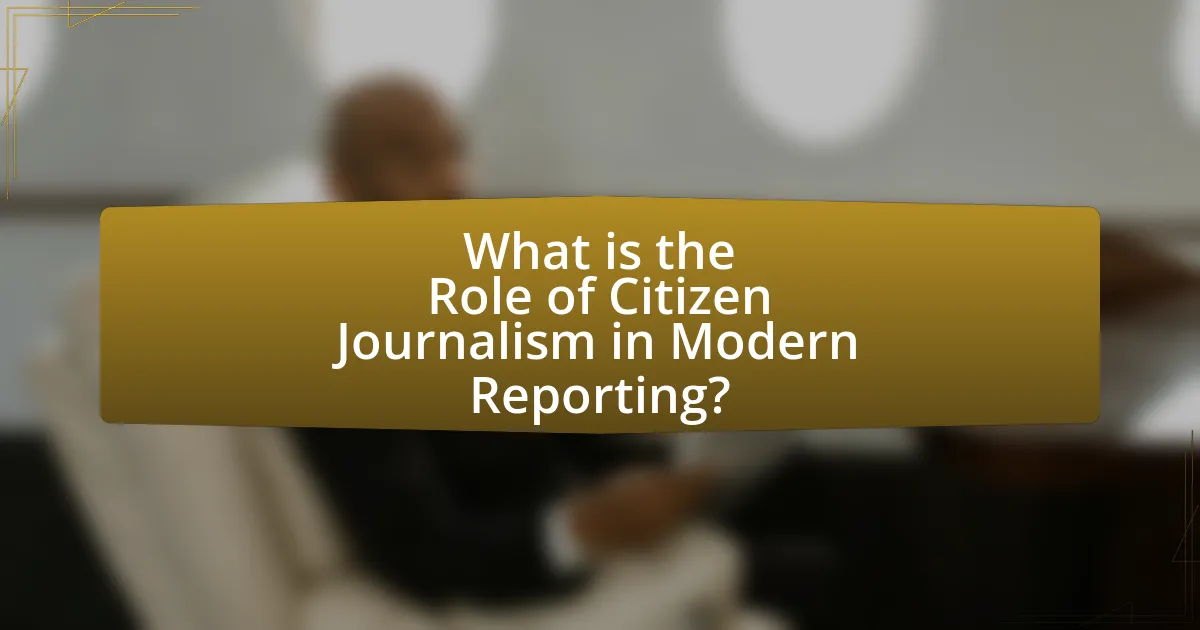Citizen journalism is a vital component of modern reporting, offering real-time information and diverse perspectives often overlooked by traditional media. This article explores the evolution of citizen journalism in the digital age, highlighting the impact of technological advancements such as smartphones and social media platforms. It examines the unique contributions of citizen journalists, including their role in enhancing accountability and providing localized insights, while also addressing challenges related to credibility, misinformation, and legal considerations. The interaction between citizen journalism and traditional media is analyzed, along with best practices for ensuring accuracy and ethical reporting. Overall, the article underscores the significance of citizen journalism in fostering a more informed society and its potential future developments.

What is the Role of Citizen Journalism in Modern Reporting?
Citizen journalism plays a crucial role in modern reporting by providing real-time information and diverse perspectives that traditional media may overlook. This form of journalism empowers ordinary individuals to document events, share experiences, and disseminate news through platforms like social media, often leading to faster coverage of breaking news. For instance, during the Arab Spring, citizen journalists used mobile phones to capture and share footage of protests, significantly influencing global awareness and response. Additionally, studies indicate that citizen journalism can enhance accountability by allowing marginalized voices to be heard, thus enriching the public discourse and fostering a more informed society.
How has citizen journalism evolved in the digital age?
Citizen journalism has evolved significantly in the digital age through the widespread use of social media platforms and mobile technology, enabling individuals to report news in real-time. This transformation has democratized information dissemination, allowing ordinary citizens to share their perspectives and experiences directly with a global audience. For instance, during events like the Arab Spring, citizen journalists utilized smartphones and social media to document protests and government responses, providing firsthand accounts that traditional media outlets often could not access. Additionally, the rise of platforms like Twitter and Facebook has facilitated the rapid spread of news, making it easier for citizen journalists to reach large audiences and influence public discourse.
What technological advancements have facilitated citizen journalism?
Technological advancements such as smartphones, social media platforms, and live-streaming technology have significantly facilitated citizen journalism. Smartphones enable individuals to capture high-quality images and videos, allowing them to report news events in real-time. Social media platforms like Twitter and Facebook provide a wide-reaching audience for citizen journalists, enabling rapid dissemination of information. Live-streaming technology allows users to broadcast events as they happen, increasing the immediacy and impact of citizen reporting. These advancements have transformed ordinary individuals into active participants in the news-gathering process, contributing to a more diverse media landscape.
How do social media platforms influence citizen journalism?
Social media platforms significantly influence citizen journalism by providing accessible tools for reporting and disseminating information. These platforms enable individuals to share news and events in real-time, often bypassing traditional media gatekeepers. For instance, during events like protests or natural disasters, citizens can upload videos and updates directly to platforms such as Twitter and Facebook, allowing for immediate public awareness and engagement. Research indicates that 62% of adults in the U.S. get news from social media, highlighting its role as a primary source of information. This shift empowers ordinary individuals to act as journalists, contributing to a more diverse media landscape and facilitating grassroots reporting.
Why is citizen journalism important in today’s media landscape?
Citizen journalism is important in today’s media landscape because it democratizes information dissemination and provides diverse perspectives that traditional media may overlook. This form of journalism empowers ordinary individuals to report news events, often in real-time, which enhances the speed and breadth of information available to the public. For instance, during significant events like protests or natural disasters, citizen journalists can capture and share firsthand accounts and images, contributing to a more comprehensive understanding of the situation. Research by the Pew Research Center indicates that 72% of Americans believe that citizen journalism plays a crucial role in providing information that mainstream media might miss, highlighting its significance in fostering a more informed society.
What unique perspectives do citizen journalists provide?
Citizen journalists provide unique perspectives by offering firsthand accounts and localized insights that traditional media may overlook. Their proximity to events allows them to capture real-time information and diverse viewpoints, often reflecting the experiences of underrepresented communities. For instance, during the Arab Spring, citizen journalists played a crucial role in documenting protests and government responses, providing a narrative that contrasted with mainstream media coverage. This grassroots reporting enhances the overall media landscape by introducing varied narratives and fostering a more inclusive dialogue.
How does citizen journalism contribute to accountability in reporting?
Citizen journalism enhances accountability in reporting by providing diverse perspectives and immediate coverage of events, often filling gaps left by traditional media. This form of journalism empowers individuals to document and share information, which can lead to increased scrutiny of public figures and institutions. For instance, during the Arab Spring, citizen journalists used social media to report on protests and government actions, holding authorities accountable for their responses. Additionally, platforms like Twitter and Facebook allow for real-time fact-checking and dissemination of information, which can challenge misinformation and promote transparency. This active participation of citizens in the news cycle fosters a culture of accountability, as it encourages both traditional media and public officials to be more responsive to the public’s concerns.

What challenges does citizen journalism face?
Citizen journalism faces several significant challenges, including issues of credibility, lack of resources, and legal risks. Credibility is a major concern as citizen journalists often lack formal training, which can lead to the dissemination of misinformation. A study by the Pew Research Center in 2017 found that 64% of Americans believe that fake news has caused confusion about basic facts. Additionally, citizen journalists typically operate without the financial backing that traditional media organizations have, limiting their access to resources such as legal support and professional tools. Legal risks also pose a challenge, as citizen journalists may face threats of lawsuits or arrest, particularly in politically sensitive environments; for instance, the Committee to Protect Journalists reported that in 2020, at least 274 journalists were jailed worldwide, many of whom were citizen journalists covering protests or government actions. These challenges hinder the effectiveness and safety of citizen journalism in modern reporting.
How do issues of credibility and reliability affect citizen journalism?
Issues of credibility and reliability significantly impact citizen journalism by influencing public trust and the perceived legitimacy of the information shared. When citizen journalists produce content, the lack of formal training and editorial oversight can lead to the dissemination of unverified or biased information, which undermines their credibility. For instance, a study by the Pew Research Center in 2018 found that 62% of Americans believe that social media platforms are filled with misinformation, which directly affects how citizen-generated content is received. Consequently, if audiences question the reliability of citizen journalism, they may disregard valuable insights or eyewitness accounts, ultimately diminishing the role of citizen journalists in modern reporting.
What measures can be taken to verify citizen-generated content?
To verify citizen-generated content, several measures can be implemented, including cross-referencing information with established news sources, utilizing fact-checking organizations, and employing digital verification tools. Cross-referencing involves comparing the content against credible news outlets to confirm accuracy. Fact-checking organizations, such as Snopes and FactCheck.org, specialize in assessing the validity of claims and can provide reliable verification. Digital verification tools, like reverse image search and metadata analysis, help ascertain the authenticity of images and videos, ensuring that the content is not manipulated or taken out of context. These measures collectively enhance the credibility of citizen-generated content in the realm of journalism.
How do misinformation and fake news impact citizen journalism?
Misinformation and fake news significantly undermine citizen journalism by eroding trust and credibility. When citizen journalists disseminate inaccurate information, it can lead to public skepticism about their reports, diminishing the perceived reliability of grassroots reporting. A study by the Pew Research Center found that 64% of Americans believe that fake news has caused confusion about basic facts, which directly affects how audiences engage with citizen-generated content. This environment of distrust can discourage citizen journalists from participating, as they may fear backlash or criticism for sharing unverified information.
What legal and ethical considerations surround citizen journalism?
Citizen journalism raises significant legal and ethical considerations, primarily concerning issues of defamation, privacy, and the accuracy of information. Legal frameworks often hold citizen journalists to the same standards as traditional journalists, meaning they can face lawsuits for publishing false information that harms individuals or organizations. For instance, in the United States, defamation laws require proof of falsehood and harm, which citizen journalists must navigate carefully to avoid legal repercussions.
Ethically, citizen journalists are challenged to maintain objectivity and verify facts, as the lack of formal training can lead to the spread of misinformation. The Society of Professional Journalists emphasizes the importance of accuracy and fairness, principles that citizen journalists should uphold to maintain credibility. Furthermore, ethical dilemmas arise regarding the invasion of privacy, especially when reporting on sensitive topics or individuals without consent. These legal and ethical frameworks are crucial for ensuring responsible reporting in the evolving landscape of citizen journalism.
What rights do citizen journalists have under current laws?
Citizen journalists have the right to gather and disseminate information under current laws, similar to traditional journalists, but these rights can vary significantly by jurisdiction. In many countries, citizen journalists are protected by freedom of speech and press laws, which allow them to report on matters of public interest without censorship. For example, in the United States, the First Amendment protects the rights of individuals to express their views and share information, including through digital platforms. However, citizen journalists may face legal challenges, such as defamation claims or restrictions on recording in certain public spaces, which can limit their ability to report freely. Additionally, laws regarding copyright and privacy can also impact the rights of citizen journalists, as they must navigate these legal frameworks while producing their content.
How can citizen journalists navigate ethical dilemmas in reporting?
Citizen journalists can navigate ethical dilemmas in reporting by adhering to established journalistic standards and principles, such as accuracy, fairness, and accountability. They should verify information through multiple reliable sources before publication to ensure factual integrity. For instance, the Society of Professional Journalists emphasizes the importance of minimizing harm and acting independently, which citizen journalists can adopt to maintain credibility. Additionally, engaging with the community and understanding the context of the stories they cover can help them make informed ethical decisions. By following these guidelines, citizen journalists can effectively address ethical challenges while contributing valuable perspectives to modern reporting.

How does citizen journalism interact with traditional media?
Citizen journalism interacts with traditional media by providing alternative perspectives and real-time information that can enhance news coverage. Traditional media often relies on citizen-generated content for breaking news, as seen during events like the Arab Spring, where social media and citizen reports played a crucial role in disseminating information quickly. This interaction can lead to a more diverse narrative, as traditional outlets may incorporate citizen journalism to fill gaps in their reporting, thereby increasing audience engagement and trust. Additionally, traditional media sometimes adopts citizen journalism practices, such as crowdsourcing information, to enhance their reporting accuracy and relevance.
What role do traditional media outlets play in relation to citizen journalism?
Traditional media outlets serve as both a platform and a gatekeeper for citizen journalism, amplifying grassroots reporting while also maintaining editorial standards. They often incorporate citizen-generated content into their coverage, which can enhance the diversity of perspectives presented in news stories. For instance, during events like natural disasters or protests, traditional media frequently rely on citizen journalists for real-time updates and firsthand accounts, thereby enriching their reporting. This relationship is supported by studies showing that traditional media outlets that engage with citizen journalism can increase audience trust and engagement, as seen in the aftermath of the 2011 Arab Spring, where citizen reports were crucial for mainstream media narratives.
How can traditional media benefit from citizen journalism?
Traditional media can benefit from citizen journalism by gaining access to diverse perspectives and real-time information. Citizen journalists often report on events as they unfold, providing traditional media outlets with timely content that enhances their news coverage. For instance, during the Arab Spring, citizen journalists used social media to share firsthand accounts and images, which traditional media outlets utilized to provide more comprehensive reporting. This collaboration allows traditional media to engage with audiences more effectively and to cover stories that may otherwise go unnoticed.
What tensions exist between citizen journalists and professional reporters?
Tensions between citizen journalists and professional reporters primarily stem from issues of credibility, ethics, and competition. Professional reporters often question the reliability of information provided by citizen journalists, who may lack formal training and adherence to journalistic standards. This skepticism is supported by studies indicating that misinformation can spread rapidly through unverified citizen reporting, undermining public trust in news media. Additionally, the rise of citizen journalism has led to competition for audience attention and advertising revenue, creating friction as traditional media outlets adapt to a changing landscape. These dynamics highlight the ongoing struggle between established journalistic practices and the democratization of news reporting through citizen involvement.
What are the future prospects for citizen journalism?
The future prospects for citizen journalism are promising, driven by advancements in technology and increasing public engagement. As smartphones and social media platforms become ubiquitous, individuals can easily document and share news events in real-time, enhancing the immediacy and diversity of news coverage. A study by the Pew Research Center in 2021 indicated that 53% of Americans believe that citizen journalism plays a crucial role in providing information about local issues, highlighting its growing importance in the media landscape. Furthermore, as traditional media outlets face challenges such as declining trust and financial instability, citizen journalism offers an alternative that can fill gaps in coverage, particularly in underreported areas. This trend suggests that citizen journalism will continue to evolve, becoming an integral part of the broader media ecosystem.
How might emerging technologies shape the future of citizen journalism?
Emerging technologies will significantly shape the future of citizen journalism by enhancing accessibility, improving content creation, and facilitating real-time reporting. With the proliferation of smartphones and social media platforms, individuals can easily capture and disseminate news, leading to a more democratized information landscape. For instance, a Pew Research Center study found that 72% of Americans get news from social media, highlighting the shift towards user-generated content. Additionally, advancements in artificial intelligence and machine learning can assist citizen journalists in analyzing data and identifying trends, further enriching the quality of reporting. These technologies not only empower citizens to act as reporters but also challenge traditional media by providing alternative narratives and perspectives.
What trends are likely to influence the growth of citizen journalism?
The growth of citizen journalism is likely to be influenced by the increasing accessibility of technology and social media platforms. As smartphones and internet access become more widespread, individuals can easily capture and share newsworthy events in real-time. According to a 2021 Pew Research Center study, 86% of Americans own a smartphone, facilitating the rise of citizen-generated content. Additionally, the decline of traditional media outlets and the demand for diverse perspectives are driving audiences to seek information from citizen journalists. This shift is supported by the fact that 64% of U.S. adults believe that citizen journalism provides valuable insights that mainstream media may overlook.
What best practices should citizen journalists follow?
Citizen journalists should follow best practices such as verifying information before publication, maintaining ethical standards, and ensuring transparency in their reporting. Verifying information involves cross-checking facts with reliable sources to prevent the spread of misinformation, which is crucial given that 60% of social media users encounter false information regularly. Maintaining ethical standards includes respecting privacy and avoiding conflicts of interest, as outlined by the Society of Professional Journalists’ Code of Ethics. Transparency can be achieved by disclosing sources and methods, which builds trust with the audience and enhances credibility. These practices contribute to the integrity and reliability of citizen journalism in modern reporting.
How can citizen journalists ensure accuracy in their reporting?
Citizen journalists can ensure accuracy in their reporting by verifying information through multiple credible sources before publication. This practice is essential as it helps to confirm the reliability of the facts being reported. For instance, a study by the Pew Research Center found that cross-referencing information with established news outlets significantly increases the likelihood of accurate reporting. Additionally, citizen journalists should utilize fact-checking tools and platforms, such as Snopes or FactCheck.org, to validate claims. Engaging with experts in the relevant field can also provide insights that enhance the accuracy of the reported information.
What strategies can enhance the impact of citizen journalism?
To enhance the impact of citizen journalism, strategies such as fostering community engagement, utilizing social media platforms effectively, and providing training for citizen journalists are essential. Community engagement encourages local participation, which can lead to more relevant and timely reporting. Effective use of social media allows citizen journalists to reach wider audiences quickly; for instance, platforms like Twitter have been instrumental in disseminating news during crises. Additionally, training programs can equip citizen journalists with skills in ethics, fact-checking, and storytelling, thereby improving the quality of their reporting. Research by the Pew Research Center indicates that citizen journalism can significantly influence public discourse when these strategies are implemented effectively.

Leave a Reply